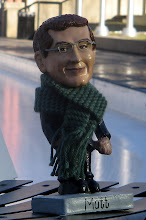 Last week I bought a pack of 12 colored Sharpie pens, thinking I would find some musical purpose to use them. (That would allow me to deduct them on my tax return, right?) I wasn't sure quite what purpose, but lately I hear so many people talk about color - use a different color here, match the viola's color there, etc. - and so I thought maybe I could use some more of it.
Last week I bought a pack of 12 colored Sharpie pens, thinking I would find some musical purpose to use them. (That would allow me to deduct them on my tax return, right?) I wasn't sure quite what purpose, but lately I hear so many people talk about color - use a different color here, match the viola's color there, etc. - and so I thought maybe I could use some more of it.After an hour practicing the Prelude from Bach's 1st Cello Suite this evening, I had a big stack of Sharpies massed on the bottom of my stand. I was having a great time picking different colors for each measure's harmonic change, highlighting the 3-note figure that usually arcs up, creating the impetus for the whole piece. I have worked on this Prelude a lot, but somehow just putting colors on the page was making it more fun and exciting to work on than it had been for a long time. Or maybe I was getting high on those marker fumes.
Yesterday afternoon I played the Prelude for Ed Barker in a masterclass, and he had a lot of great comments. He talked about the bowing in this Barenreiter edition, which is the one found in the Anna Magdalena autograph - generally 3 slurred and 5 separate. He described this as a good "representative bowing", indicative of how a performer at the time might have chosen to play the piece - also, a guide to the importance of that three-note gesture. So we can choose to do something different - lately I have been doing 2 slurred, 6 separate, which helps me to not drift out to the tip - but we should always keep the character of that motive in mind.
He showed me how I could lean into that motive, especially on the downbeats but also as an echo in the middle of the bars, bringing out the harmonic rhythm. Just finding a nice, clear way to structure a single bar of the piece seemed to help organize it better in my mind, and all those repeating notes started to form into gestures and directions. We talked about ways to create the resonance of the cello's open strings - even though we don't have them on the bass.
The challenge is to make a piece which is not especially idiomatic for our instrument sound completely idiomatic, as it would be on the cello. It might seem like a lost cause, but when you hear someone like Ed manage it (even on an unfamiliar bass), it gives you hope to keep trying!


 Technorati Link Count: no. of blog reactions to this post
Technorati Link Count: no. of blog reactions to this post
1 comment:
Hi Matt,
Yeah, I'm always teased by my students for being "color man". Because I love to draw all over the score as you described.
Isn’t Ed Barker amazing?!
The 3 slurred then 4 separate is a nice option for the prelude, and you see it in the Kellner, Westphal, and Vienna anonymous manuscripts. But when I look closely at Anna Magdalena I see this:
M1: xx__ xxxx xx__ xxxx
M2: x__x xxxx x__x xxxx
M3: xxxx xxxx xxxx xxxx
M4: ___x xxxx ___x xxxx
Try it. It's terrific, because no one measure is like another (asymmetry in Baroque art), you always start the second half of M1 and M2 with an up bow, which helps quell the monotony, and M3, the dominant measure is bowed separately = emphatic, (depending on how you read the line under the d in the word Prelude).
Congratulations on your new job!
Nicholas Walker
Post a Comment